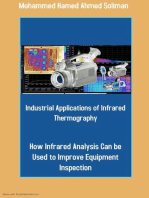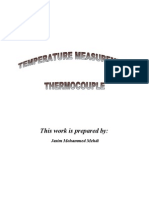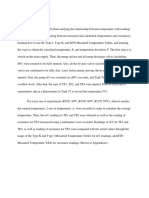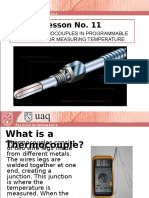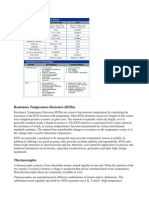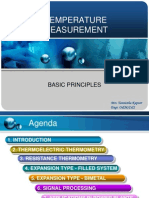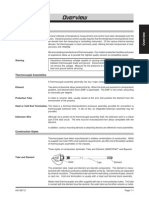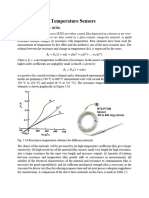0 ratings0% found this document useful (0 votes)
14 viewsWhat Is A Thermocouple Sensor?: View A Complete Reference Table
What Is A Thermocouple Sensor?: View A Complete Reference Table
Uploaded by
sankarsuper83A thermocouple is a sensor that measures temperature using two dissimilar metals joined together. The main types are J, K, T, and E, which have different temperature ranges and applications. Factors like temperature range, chemical resistance, and installation requirements are used to choose the thermocouple type. Grounded, ungrounded, and exposed junction types have tradeoffs in response time and electrical isolation.
Copyright:
© All Rights Reserved
Available Formats
Download as DOCX, PDF, TXT or read online from Scribd
What Is A Thermocouple Sensor?: View A Complete Reference Table
What Is A Thermocouple Sensor?: View A Complete Reference Table
Uploaded by
sankarsuper830 ratings0% found this document useful (0 votes)
14 views7 pagesA thermocouple is a sensor that measures temperature using two dissimilar metals joined together. The main types are J, K, T, and E, which have different temperature ranges and applications. Factors like temperature range, chemical resistance, and installation requirements are used to choose the thermocouple type. Grounded, ungrounded, and exposed junction types have tradeoffs in response time and electrical isolation.
Original Description:
neqw
Original Title
Chassis
Copyright
© © All Rights Reserved
Available Formats
DOCX, PDF, TXT or read online from Scribd
Share this document
Did you find this document useful?
Is this content inappropriate?
A thermocouple is a sensor that measures temperature using two dissimilar metals joined together. The main types are J, K, T, and E, which have different temperature ranges and applications. Factors like temperature range, chemical resistance, and installation requirements are used to choose the thermocouple type. Grounded, ungrounded, and exposed junction types have tradeoffs in response time and electrical isolation.
Copyright:
© All Rights Reserved
Available Formats
Download as DOCX, PDF, TXT or read online from Scribd
Download as docx, pdf, or txt
0 ratings0% found this document useful (0 votes)
14 views7 pagesWhat Is A Thermocouple Sensor?: View A Complete Reference Table
What Is A Thermocouple Sensor?: View A Complete Reference Table
Uploaded by
sankarsuper83A thermocouple is a sensor that measures temperature using two dissimilar metals joined together. The main types are J, K, T, and E, which have different temperature ranges and applications. Factors like temperature range, chemical resistance, and installation requirements are used to choose the thermocouple type. Grounded, ungrounded, and exposed junction types have tradeoffs in response time and electrical isolation.
Copyright:
© All Rights Reserved
Available Formats
Download as DOCX, PDF, TXT or read online from Scribd
Download as docx, pdf, or txt
You are on page 1of 7
Chassis: Different types of chassis a
What is a thermocouple sensor?
A thermocouple is a sensor for measuring temperature. It consists of two dissimilar metals, joined together at one end. When the
junction of the two metals is heated or cooled a voltage is produced that can be correlated back to the temperature. The
thermocouple alloys are commonly available as wire.
What are the different thermocouple types?
A thermocouple is available in different combinations of metals or calibrations. The four most common calibrations are J, K, T and E.
There are high temperature calibrations R, S, C and GB. Each calibration has a different temperature range and environment,
although the maximum temperature varies with the diameter of the wire used in the thermocouple. Although the thermocouple
calibration dictates the temperature range, the maximum range is also limited by the diameter of the thermocouple wire. That is, a
very thin thermocouple may not reach the full temperature range.
View a complete reference table for each thermocouple. The table includes international color codes for thermocouple alloys,
temperature range and limits of error for almost every kind of thermocouple.
How do I choose a thermocouple type?
Because a thermocouple measures in wide temperature ranges and can be relatively rugged, thermocouples are very often used in
industry. The following criteria are used in selecting a thermocouple:
Temperature range
Chemical resistance of the thermocouple or sheath material
Abrasion and vibration resistance
Installation requirements (may need to be compatible with existing equipment; existing holes may determine probe
diameter)
How do I know which junction type to choose?
Sheathed thermocouple probes are available with one of three junction types: grounded, ungrounded or exposed (see graphic
below:"Thermocouple Tip Styles"). At the tip of a grounded junction probe, the thermocouple wires are physically attached to the
inside of the probe wall. This results in good heat transfer from the outside, through the probe wall to the thermocouple junction. In
an ungrounded probe, the thermocouple junction is detached from the probe wall. Response time is slower than the grounded style,
but the ungrounded offers electrical isolation (see table below).
Room-Temperature Insulation Resistance
Ungrounded Thermocouple
Nominal Sheath Diameter
Applied dc Voltage
min.
Insulation Resistance
min.
Less than 0.90mm (0.03in.) 50V 100M Ohms
0.80-1.5mm (0.030 to
0.059in.)
50V 500M Ohms
Greater than 1.5mm
(0.059in.)
500V 1000M Ohms
The thermocouple in the exposed junction style protrudes out of the tip of the sheath and is exposed to the surrounding
environment. This type offers the best response time, but is limited in use to dry, noncorrosive and nonpressurized applications.
What is response time?
A time constant has been defined as the time required by a sensor to reach 63.2% of a step change in temperature under a specified
set of conditions. Five time constants are required for the sensor to approach 100% of the step change value. An exposed junction
thermocouple is the fastest responding. Also, the smaller the probe sheath diameter, the faster the response, but the maximum
temperature may be lower. Be aware, however, that sometimes the probe sheath cannot withstand the full temperature range of
the thermocouple type.
Material
Maximum
Temperature
Application Atmosphere
Oxidizing Hydrogen Vacuum Inert
304 SS 900C (1650F)
Very
Good
Good
Very
Good
Very
Good
Inconel
600
1148C (2100F)
Very
Good
Good
Very
Good
Very
Good
Thermocouple Ranges and Limits of Error
The table below shows temperature ranges and accuracy for J, K, E and T thermocouples. Additional thermocouple types.
Thermocouple Reference Tables
Thermocouples produce a voltage output that can be correlated to the temperature that the thermocouple is measuring. The
documents in the table below provide the thermoelectric voltage and corresponding temperature for a given thermocouple type.
Most of the documents also provide the thermocouple temperature range, limits of error and environmental considerations.
click on a link below to see the related document
Thermocouple Type B( C)
Thermocouple Type B( F)
Thermocouple Type C( C)
Thermocouple Type C( F)
Thermocouple Type E( C)
Thermocouple Type E( F)
Thermocouple Type J( C)
Thermocouple Type J( F)
Thermocouple Type K( C)
Thermocouple Type K( F)
Thermocouple Type N( C)
Thermocouple Type N( F)
Thermocouple Type R( C)
Thermocouple Type R( F)
Thermocouple Type S( C)
Thermocouple Type S( F)
Thermocouple Type T( C)
Thermocouple Type T( F)
Tungsten and Tungsten/
Rhenium
CHROMEGA vs. Gold-0.07
Atomic Percent Iron
Types of Thermocouples
Beaded Wire Thermocouple
A beaded wire thermocouple is the simplest form of thermocouple. It consists of two pieces of thermocouple
wire joined together with a welded bead. Because the bead of the thermocouple is exposed, there are several
application limitations. The beaded wire thermocouple should not be used with liquids that could corrode or
oxidize the thermocouple alloy. Metal surfaces can also be problematic. Often metal surfaces, especially pipes
are used to ground electrical systems The indirect connection to an electrical system could impact the
thermocouple measurement. In general, beaded wire thermocouples are a good choice for the measurement
of gas temperature. Since they can be made very small, they also provide very fast response time.
Thermocouple Probe
A thermocouple probe consists of thermocouple wire housed inside a metallic tube. The wall of the tube is
referred to as the sheath of the probe. Common sheath materials include stainless steel and Inconel. Inconel
supports higher temperature ranges than stainless steel, however, stainless steel is often preferred because of
its broad chemical compatibility. For very high temperatures, other exotic sheath materials are also available.
View our line of high temperature exotic thermocouple probes.
The tip of the thermocouple probe is available in three different styles. Grounded, ungrounded and exposed.
With a grounded tip the thermocouple is in contact with the sheath wall. A grounded junction provides a fast
response time but it is most susceptible to electrical ground loops. In ungrounded junctions, the thermocouple
is separated from the sheath wall by a layer of insulation. The tip of the thermocouple protrudes outside the
sheath wall with an exposed junction. Exposed junction thermocouples are best suited for air measurement.
Thermocouple Tip Styles
Grounded
Thermocouple
Ungrounded
Thermocouple
Exposed
Thermocouple
Surface Probe
Measuring the temperature of a solid surface is difficult for most types of temperature sensors. In order to
assure an accurate measurement, the entire measurement area of the sensor must be in contact with the
surface. This is difficult when working with a rigid sensor and a rigid surface. Since thermocouples are made of
pliable metals, the junction can be formed flat and thin to provide maximum contact with a rigid solid surface.
These thermocouples are an excellent choice for surface measurement. The thermocouple can even be built in
a mechanism which rotates, making it suitable for measuring the temperature of a moving surface. Type K is
ChromegaAlomega.
Top Search Results for THERMOCOUPLES
5LRTC, and 5SRTC Series : Ready-Made Insulated Thermocouples with Kapton...
www.omega.com/pptst/5LSC_5SRTC.html - 89k - Wednesday, May 07, 2014
5TC SERIES : Ready-Made Insulated Thermocouples - Package of 5
www.omega.com/pptst/5TC.html - 75k - Wednesday, May 07, 2014
88000 Series : Thin Leaf-Type Thermocouples
www.omega.com/pptst/88000_thinfoil.html - 69k - Wednesday, May 07, 2014
ADR and ADF : Adjustable Depth Armored Thermocouples
www.omega.com/pptst/ADR_ADF_PROBES.html - 80k - Wednesday, May 07, 2014
BT Series : Bayonet Style Thermocouples with Stainless Steel Cable
www.omega.com/pptst/BT-000_BT-090.html - 84k - Wednesday, May 07, 2014
CF Series : Thermocouples for Extruders - Compression Style with Stainless ...
www.omega.com/pptst/CF-000_CF-090.html - 99k - Wednesday, May 07, 2014
Anemometers | Automation | Accelerometers | Calibrators | Cartridge Heaters | Chart
Recorders | Cryogenics | Custom Pressure Transducers | Data Loggers | Data Acquisition | Dial
Thermometers | Fiber Optics | Flexible Heaters | Flowmeters | Glass Bulb Thermometers |
Grippers | Heaters | Humidity Measurement | Integrated Circuit Sensors | Immersion Heaters |
Infrared Thermometers | Level Measurement | Load Cells | M12 Temperature Connectors |
Magnetic Flow Meters | Panel Meters | Pressure Gauges | Pressure Transducers | Rotameters |
RTD | Remote Process Monitoring | Sanitary Sensors | Signal Conditioners | Stepper Motors |
Strain Gages | Strip Heaters | Temperature Controllers | Temperature Labels | Temperature
Measurement | Temperature Sensor Manufacturing | Temperature Sensors | Temperature
Transmitters | Thermal Imagers | Thermistors | Thermocouple | Thermoc
nd their construction, Chassis dimensions.
You might also like
- Industrial Applications of Infrared Thermography: How Infrared Analysis Can be Used to Improve Equipment InspectionFrom EverandIndustrial Applications of Infrared Thermography: How Infrared Analysis Can be Used to Improve Equipment InspectionRating: 4.5 out of 5 stars4.5/5 (3)
- Thermocouple Questions and AnswersDocument12 pagesThermocouple Questions and AnswersJêmš Navik0% (1)
- Thermocouple PDFDocument6 pagesThermocouple PDFibrahim2129047No ratings yet
- Various Temperature MeasurementsDocument3 pagesVarious Temperature MeasurementsPrincess PurnimaNo ratings yet
- This Work Is Prepared By:: Jasim Mohammed MehdiDocument12 pagesThis Work Is Prepared By:: Jasim Mohammed MehdiJasim Al-rubayieNo ratings yet
- Thermocouple NotesDocument5 pagesThermocouple NotesJane Marek100% (1)
- Temperature MeasurementDocument35 pagesTemperature MeasurementAlaa Shahwan88% (8)
- ThermocoupleDocument15 pagesThermocoupleHuzaimah JaiminNo ratings yet
- Information Desk Ajay SysconDocument8 pagesInformation Desk Ajay SysconSohel BangiNo ratings yet
- Laboratory Set Up For The Temperature Measurement of KilnDocument12 pagesLaboratory Set Up For The Temperature Measurement of KilnEr Shankar Singh DhamiNo ratings yet
- WP 003 Endress TemperatureDocument17 pagesWP 003 Endress Temperaturevenkatesh425No ratings yet
- Lec One Sensors-1Document26 pagesLec One Sensors-1Basma EltanekhyNo ratings yet
- Thermocouples: Prepared By: K Krishna Kishore 4 Year ECE 15F41A0440 Presented To: Mr. S. Nanda Kishore (PH.D.)Document17 pagesThermocouples: Prepared By: K Krishna Kishore 4 Year ECE 15F41A0440 Presented To: Mr. S. Nanda Kishore (PH.D.)k k100% (1)
- Measurement of TemperatureDocument24 pagesMeasurement of Temperaturehadeed shaikhNo ratings yet
- 14 Common Questions About Thermocouple Temperature MeasurementDocument6 pages14 Common Questions About Thermocouple Temperature MeasurementYiDan LiNo ratings yet
- CLB21103 Process Instrumentation Experiment 5: Thermocouple RTD MeasurementDocument9 pagesCLB21103 Process Instrumentation Experiment 5: Thermocouple RTD MeasurementSiti Hajar MohamedNo ratings yet
- Thermocouple: From Wikipedia, The Free EncyclopediaDocument9 pagesThermocouple: From Wikipedia, The Free EncyclopediaKiệt Huỳnh AnhNo ratings yet
- Instrumentation SensorsDocument145 pagesInstrumentation SensorsGulfam ShahzadNo ratings yet
- Lesson No. 11: Using Thermocouples in Programmable Systems For Measuring TemperatureDocument8 pagesLesson No. 11: Using Thermocouples in Programmable Systems For Measuring TemperatureJavi EspinosaNo ratings yet
- What Is A ThermocoupleDocument4 pagesWhat Is A ThermocoupleusamakhanNo ratings yet
- Class 7 Temperature MeasurementDocument51 pagesClass 7 Temperature MeasurementMaher Abu-ElolaNo ratings yet
- Overview of Temperature MeasurementDocument54 pagesOverview of Temperature MeasurementGurtej SinghNo ratings yet
- RTDvs TCDocument2 pagesRTDvs TCNarain RamNo ratings yet
- R Vs T Relationship of Various Metals: SensorsDocument6 pagesR Vs T Relationship of Various Metals: SensorsAnbu AyyappanNo ratings yet
- Temperature MeasurementDocument41 pagesTemperature MeasurementSam100% (3)
- Comparison of Thermocouples, RTDS, and ThermistorsDocument2 pagesComparison of Thermocouples, RTDS, and ThermistorsAlwyzz Happie Raamzz100% (1)
- Thermocouple Fundamentals: Chief Engineer Marlin Manufacturing Corporation Cleveland, Ohio, U.S.ADocument16 pagesThermocouple Fundamentals: Chief Engineer Marlin Manufacturing Corporation Cleveland, Ohio, U.S.Ausman yimerNo ratings yet
- Temperature SenesorDocument16 pagesTemperature SenesordskjajkdsaNo ratings yet
- Difference Between RTD, Thermocouple and ThermistorDocument3 pagesDifference Between RTD, Thermocouple and ThermistorVenkata Suresh MandavaNo ratings yet
- Thermocouple: VoltageDocument7 pagesThermocouple: Voltage9897856218No ratings yet
- Lecture Notes 13Document15 pagesLecture Notes 13Abdul Hakeem Semar KamaluddinNo ratings yet
- RTD, Thermocouple, Thermistors, Manometer, Bourdon TubeDocument36 pagesRTD, Thermocouple, Thermistors, Manometer, Bourdon TubeDINESH KUMAR DRAVIDAMANI100% (1)
- Lab Session of Different Temp SensorDocument7 pagesLab Session of Different Temp SensorNouman NisarNo ratings yet
- 2 Car Sensors V1-TemperatureDocument35 pages2 Car Sensors V1-TemperatureWNo ratings yet
- Characteristics of ThermocoupleDocument6 pagesCharacteristics of ThermocouplekusumgdasNo ratings yet
- Thermocouple CalibirationDocument18 pagesThermocouple CalibirationAnonymous w6v7JWfr5100% (2)
- Thermocouple OverviewDocument22 pagesThermocouple OverviewAhmed RamadanNo ratings yet
- Rtds - or Resistance Temperature Detectors - Are Temperature Sensors That Contain A Resistor ThatDocument6 pagesRtds - or Resistance Temperature Detectors - Are Temperature Sensors That Contain A Resistor Thatmuhammad aliNo ratings yet
- Temperature MeasurementDocument42 pagesTemperature MeasurementjimsistiNo ratings yet
- RTD pt100Document6 pagesRTD pt100jyotiblossomsNo ratings yet
- Ther Mist orDocument14 pagesTher Mist orDheeraj YadavNo ratings yet
- Chapter 4Document63 pagesChapter 4MahainiIm RuzailyNo ratings yet
- Temperature SensorsDocument44 pagesTemperature SensorsManish ChadhaNo ratings yet
- Temperature Measurement in Liquid MetalDocument16 pagesTemperature Measurement in Liquid MetalkpbaijuNo ratings yet
- General Guidelines On Installation of ThermocouplesDocument15 pagesGeneral Guidelines On Installation of ThermocouplesCharu ChhabraNo ratings yet
- Temperature and HeatDocument20 pagesTemperature and HeatMer ryNo ratings yet
- THERMOMETRYDocument8 pagesTHERMOMETRYvivekmariner2812No ratings yet
- Thermocouple: Multimeter °CDocument20 pagesThermocouple: Multimeter °CMalik JameelNo ratings yet
- Above 500 Degrees C A PyrometerDocument6 pagesAbove 500 Degrees C A PyrometerCharlie Licup100% (2)
- Thermocouple ManualDocument20 pagesThermocouple Manualprateekgupta900No ratings yet
- RTD ThermistorDocument20 pagesRTD ThermistorGeethakshayaNo ratings yet
- Yamari Thermo 0411Document56 pagesYamari Thermo 0411youngonhuntNo ratings yet
- What Is A Thermocouple Sensor?: Room-Temperature Insulation Resistance Ungrounded ThermocoupleDocument3 pagesWhat Is A Thermocouple Sensor?: Room-Temperature Insulation Resistance Ungrounded ThermocoupletbmariNo ratings yet
- Sae Technical Paper Series: C. Scott Nelson, David Chen, Joseph Ralph and Eric D'HerdeDocument11 pagesSae Technical Paper Series: C. Scott Nelson, David Chen, Joseph Ralph and Eric D'HerderuchikasaxenaNo ratings yet
- Thermocouple Wire ReportDocument16 pagesThermocouple Wire ReportshadiNo ratings yet
- Temperature MeasurementsDocument10 pagesTemperature MeasurementsAhmed KamelNo ratings yet
- Electrical-Type Temperature Sensors: Resistance Thermometers / (RTD)Document7 pagesElectrical-Type Temperature Sensors: Resistance Thermometers / (RTD)Mohsin RashidNo ratings yet
- Electroplating for Amateurs: Classic Reference for Small WorkshopsFrom EverandElectroplating for Amateurs: Classic Reference for Small WorkshopsNo ratings yet
- Thermal Modelling of Power Transformers Using Computational Fluid DynamicsFrom EverandThermal Modelling of Power Transformers Using Computational Fluid DynamicsNo ratings yet
- Handbook of Mechanical and Materials EngineeringFrom EverandHandbook of Mechanical and Materials EngineeringRating: 5 out of 5 stars5/5 (4)
- Autism: Signs and SymptomsDocument1 pageAutism: Signs and Symptomssankarsuper83No ratings yet
- Answer: Ethanol (Which Is Also Called Ethyl Alcohol or Grain Alcohol, and Abbreviated AsDocument1 pageAnswer: Ethanol (Which Is Also Called Ethyl Alcohol or Grain Alcohol, and Abbreviated Assankarsuper83No ratings yet
- Centrifugal PumpDocument5 pagesCentrifugal Pumpsankarsuper83No ratings yet
- Vi Sem Before Revaluation Result Apr2014Document18 pagesVi Sem Before Revaluation Result Apr2014sankarsuper83No ratings yet
- Drastic PSR Performance.Document3 pagesDrastic PSR Performance.sankarsuper83No ratings yet
- SathyabamaUniv PlacementMaster 2015 Mech2Document182 pagesSathyabamaUniv PlacementMaster 2015 Mech2sankarsuper83100% (1)
- Mtech Energy Engg 2012Document35 pagesMtech Energy Engg 2012Ssheshan PugazhendhiNo ratings yet
- By Prime Mover: Internal Combustion Engines PlantDocument1 pageBy Prime Mover: Internal Combustion Engines Plantsankarsuper83No ratings yet
- Below 20 Revaluation Requisition LetterDocument1 pageBelow 20 Revaluation Requisition Lettersankarsuper83No ratings yet
- Sathyabama University ACADEMIC CALENDAR 2014-2015: 7 SEMESTER B.E / B.Tech BATCH: 2011-2015Document1 pageSathyabama University ACADEMIC CALENDAR 2014-2015: 7 SEMESTER B.E / B.Tech BATCH: 2011-2015sankarsuper83No ratings yet
- Add On Card Application PDFDocument2 pagesAdd On Card Application PDFraom_2No ratings yet
- Rule of Law in Armed Conflicts ProjectDocument4 pagesRule of Law in Armed Conflicts Projectsankarsuper83No ratings yet
- International Humanitarian LawDocument16 pagesInternational Humanitarian Lawsankarsuper83100% (1)
- Daimler India Commercial Vehicles PVTDocument2 pagesDaimler India Commercial Vehicles PVTsankarsuper83No ratings yet
- Krishna Peace MissionDocument2 pagesKrishna Peace Missionsankarsuper830% (1)
- Writing Style: Adding Information About Living PersonsDocument4 pagesWriting Style: Adding Information About Living Personssankarsuper83No ratings yet
